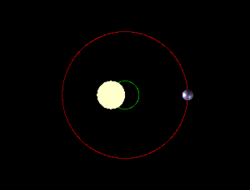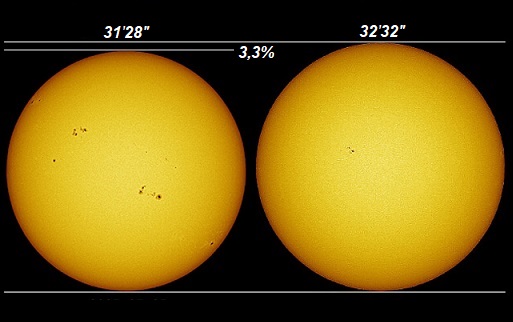On January 3, 2024, at 2:38 a.m. UTC time, our planet will pass perihelion, the point closest to the Sun in its orbit. The distance between the centers of the two bodies will be 147,100,632 km. Last year it happened on January 4, the year before that — on January 2, and next year this event will again take place on January 4. Let’s try to figure out the main issues related to it.

Why are we approaching the Sun and moving away from it at all?
As the genius Johannes Kepler established, all planets move in elliptical orbits. Ellipse is one of the types of so-called conic sections formed when a cone intersects with a plane at different angles. If this plane is perpendicular to the axis of the cone, we get a circle (a closed curve with zero eccentricity); if it is parallel, we get an open parabola with an eccentricity equal to one. Both of these cases are extremely rare, since in nature there is almost nothing “exactly equal” to an integer. The orbits of large planets are ellipses very close to a circle. The smallest eccentricity is that of Venus (0.0068), the largest is that of its “neighbor,” Mercury (0.2056).
Do not forget that the large planets affect each other by their gravity, as well as other bodies in the Solar System. Therefore, their orbital elements are constantly changing. This also applies to eccentricity: theoretically, it is possible that at some point it will become zero for some of the planets (including Earth), but this situation will not last long; gravitational perturbations will again make the orbit of this planet different from the “ideal circle”.
Why does the Earth get through perihelion on different dates?

The fact is that all the bodies of the Solar System do not orbit the Sun, but around a common center of mass, the exact position of which is determined by their mutual location. Most of all, it is influenced by the movement of Jupiter, the heaviest planet. Depending on how the Sun-Jupiter line is oriented in relation to the Earth at the time of perihelion passage, our planet will be closest to the central luminary a little earlier or later than the conditional average date. For the same reason, the distance of the Earth to the solar center at this moment varies from year to year in the range from about 146 million 320 thousand km to 147 million 875 thousand km.
Why, even though the Earth is closer to the Sun in January, is it still winter outside?
The eccentricity of the Earth’s orbit is 0.0167, that is, the difference between the smallest and largest distances from Earth to the Sun is only 3.3%. The energy flow from our star is inversely proportional to the square of the distance to it, that is, it changes by less than 7% during the year. This is quite a tangible value, but for a particular region, the change in illumination caused by fluctuations in the length of daylight and the angle of incidence of sunlight on the earth’s surface at noon is much more important in this sense (it is related to the inclination of the plane of the earth’s equator to the ecliptic). At the latitude of Kyiv, on the day of the winter solstice, our luminary is above the horizon for only 8 hours, and on the day of the summer solstice, it is above the horizon for 16 hours, that is, twice as long. Only this factor gives a doubling of the energy flow, which is significantly more than the 7% mentioned. However, for Mars, which has an orbital eccentricity of 0.092, its position in orbit also plays a significant role in seasonal changes. The organizers of the Martian missions have to take this into account.
How to determine the moment of perihelion?
Although scientists have learned to determine the moment when the Earth passes perihelion with an accuracy of minutes, it was not an easy task. Indeed, we cannot directly measure the distance to the Sun. It will also not be possible to estimate it by measuring the diameter of the solar disk: firstly, near perihelion and aphelion, when its values reach a maximum and minimum, respectively, it changes very slowly; secondly, our luminary is a huge incandescent gas ball, the size of which is not constant and depends on many factors (for example, on the phase of solar activity). Finally, we still do not have angle measuring instruments that would provide the necessary accuracy.

Astronomers were helped by Kepler’s laws, according to which the orbital velocity of the planet at perihelion should be the highest and at aphelion the lowest. This parameter can be measured by observing the spectra of stars currently located on the celestial sphere in the direction where (or from where) the Earth is “flying”. Due to the Doppler effect, the lines in these spectra deviate from the average position: in the “blue” direction — for the stars to which we are “approaching”, and in the “red” — for those from which we are moving away. It is not difficult to understand that such deviations will be maximal near perihelion. And then it remains to introduce corrections for the speed of the observer associated with the rotation of the Earth around the axis and for the distance of the Sun from the common center of mass. This method works best in the radio range.

But there is another interesting way that scientists used before the invention of high-precision spectroscopy. The fact is that the duration of a true solar day — the time interval between two consecutive upper climaxes of the Sun — also changes throughout the year, precisely because our luminary moves along the ecliptic at unequal speeds. In aphelion, it travels a shorter distance across the sky during the day (since the Earth moves more slowly around the Sun at this time), and our planet needs a little less time to “return” to the same position relative to the sun as on the previous day. On the contrary, at perihelion, this time reaches its maximum. Thus, the day when the true day lasts the longest will be the day with the smallest heliocentric distance.
Will the Earth’s perihelion always be in January?
The change of seasons on our planet is related to the position of the earth’s axis in space, and it is also not constant. Due to a phenomenon known as precession, the points of the spring and autumn equinoxes (as well as the solstices) slowly “creep” along the ecliptic towards the movement of the Sun, and those constellations that we now consider “winter”, that is, culminating around midnight in the winter months, will become “spring” in a few thousand years, but once they were “autumn”. The position of the Earth’s perihelion is also changing, but much more slowly, so over time it will pass it later and later, until its date moves to February, March, and so on. By the way, the same process has another remarkable consequence: The North Star will not always be “polar”. But this is a little different story…
Follow us on Twitter to get the most interesting space news in time
https://twitter.com/ust_magazine


